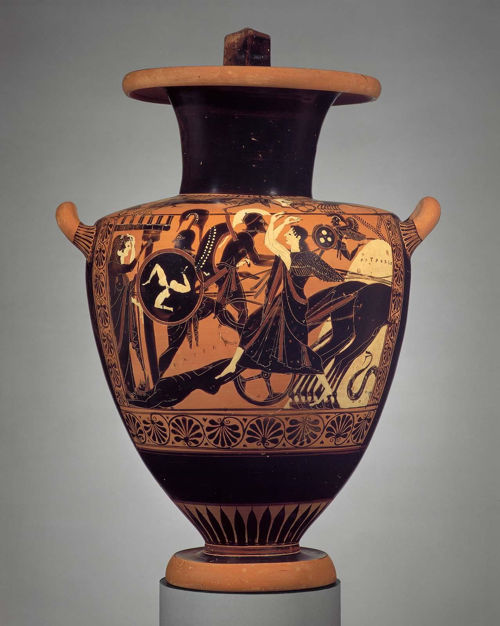Right: Achilles Drags the corpse of Hektor behind his chariot. Priam and Hecuba look on from the walls of Troy. Iris descends from Olympus to deliver Zeus’ instructions to Priam, and the psuchē (soul) or eidolon (shade, ghost) of Patroklos flies away from his burial mound, finally freed from the prison of its body.
This painting depicts the zenith of Achilles’ savagery in the Iliad, a poem that dramatizes the disastrous consequences of Achilles’ rage for Greeks and Trojans alike.
The artist has compressed space and time to tell a narrative that takes place at different times and locations during Books 22 and 23. This compression of time and space is a common technique in Greek narrative art. Full vase shown at right. Click these and any images in this collection to be taken to larger images and pages containing greater detail on the artwork.

Attic black-figure hydria Leagros Group c. 520 BCE.
(Boston Museum of Fine Arts 63.473).
Photograph © Museum of Fine Arts, Boston.
This text was designed as a companion to students reading the Iliad in various iterations of my lower level English, Classics, and Art History courses at the University at Albany from 2001 to present. It is as much a companion to my lectures as it is to the Iliad itself. Furthermore, as I teach introductory courses, I tend to use abridged versions of the text. For the past two decades, that has meant reading The Essential Homer, translated and edited by Stanley Lombardo. Lombardo’s translation is liberally quoted in the following essays, as are the editing choices (what to abridge). I do occasionally translate a line or two myself or substitute one translation for a word that I feel best fits the context. However, unless explicitly cited (intext or via footnote), translations from the Homeric text come directly from Lombardo’s translations.
This is not an all-encompassing analysis of the Iliad or even of the books covered in the epic. Instead, I focus on a handful of recurring motifs and critical approaches – primarily a functional and structural reading of the texts with occasional insertions of comparative analyses. I try to lay some basic groundwork for understanding the epic as a story in itself and as a means of understanding the milleu of Dark Age, Archaic, and Classical Greek world views that it perpetuates and reinforces in its retelling.
Major themes that these essays reinforce:
I find Lombardo’s translations do well to balance the requirements of introductory readers and fidelity to Homeric language. However, there are numerous excellent translations currently circulating. Ideally, I would suggest a new reader begin with either Lombardo’s Essential Homer (reading the abridged versions of both the Iliad and Odyssey, Hackett), or do the same with Barry Powell’s Homer's Iliad and Odyssey: The Essential Books (Oxford).
From there, I would suggest full text translations from either author, or other current works by Caroline Alexander (Harper Collins), Emily Wilson (Norton), or veritable slew of recent translations.
Lastly, however, and only after reading the epic(s) in their full form, one should read Richard Lattimore’s translation (Chicago UP). Lattimore’s work is a line translation and excises the Latinized characters from Greek names. It’s a harder read, and it lacks poetry or fluidity in modern English, instead aiming for fidelity to the original Greek words and line numbers…only making concessions for the requirements of English syntax. It’s a must read for any aspiring Homeric scholar, but it’s not a great first read. It is also my favorite translation of Apollo’s pivotal speech on pity in Book 24 of the Iliad, which sadly is omitted by both abridged translations.
Start with Albin Lesky's text. It's more of a general overview (one of fifty that could do the job, but Lesky was pretty thorough). The rest of the list doesn't really require a reading order. I would suggest starting with some of the essay collections as they're easier to follow. This list is foundational and doesn't require knowledge of Homeric Greek, but like my essays, they do teach some important terms.
Artifacts in this gallery belong to the public domain unless otherwise stated in the caption. Clicking on images in the public domain will open a lightbox to view larger versions of the art with the option to download it. Artwork released under the various Creative Commons Sharealike, Attribution, Noncomercial, etc. use licenses will open a new tab linked to the source material.